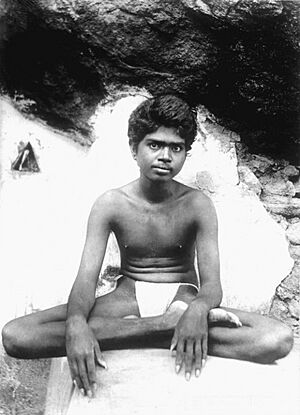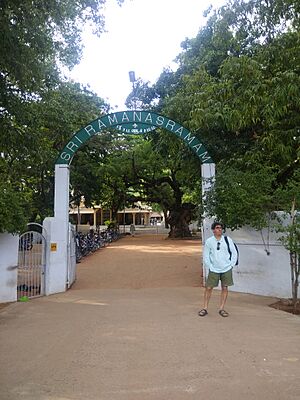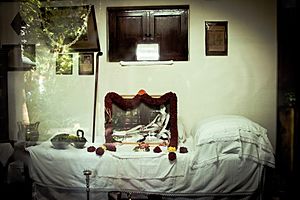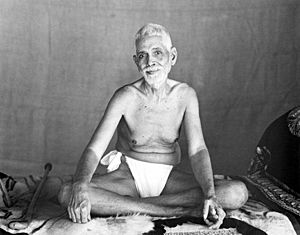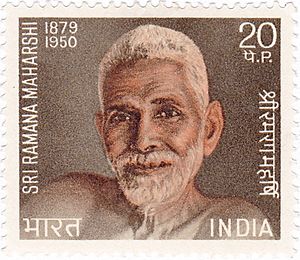Ramana Maharshi facts for kids
Quick facts for kids Ramana Maharshi |
|
|---|---|

Ramana Maharshi in his late 60s
|
|
| Birth Date | 30 December 1879 Tiruchuzhi, Virudhunagar, Madras Presidency, British India (Now Tamil Nadu, India) |
| Died on | 14 April 1950 (aged 70) Sri Ramana Ashram, Tiruvannamalai, Tamilnadu, India |
| Birth name | Venkataraman Iyer |
| Guru/teacher | Arunachala |
| Philosophy | Self-enquiry (Jnana Yoga) |
Ramana Maharshi (born Venkataraman Iyer; 30 December 1879 – 14 April 1950) was a famous Indian Hindu teacher. Many people saw him as a wise person or a "liberated being." He is mostly known as Bhagavan Sri Ramana Maharshi.
He was born in Tiruchuli, Tamil Nadu, India. When he was 16, he had a powerful experience. He felt a "current" or "force" that he realized was his true self. He later called this "the state of mind of Iswara or the jnani." Six weeks later, he left his home. He traveled to the holy mountain Arunachala in Tiruvannamalai. He lived there for the rest of his life as a sannyasin, a person who gives up worldly things.
Many people came to him. They saw him as a special spiritual leader, like an avatar of Shiva. They visited him for darshan, which means "the sight of God." Later, a spiritual center called an ashram grew around him. Visitors would sit quietly with him and ask questions. Since the 1930s, his teachings became known in the West.
Ramana Maharshi taught different ways to find spiritual peace. He especially suggested a method called self-enquiry. This means asking "Who am I?" to remove confusion and find inner peace. He also taught the importance of bhakti (devotion) or surrendering to one's true self.
Life Story
Early Years (1879–1895)

Ramana Maharshi was born Venkataraman Iyer on 30 December 1879. He was born in a village called Tiruchuli in South India. His family was a traditional Hindu Brahmin family. His father was Sundaram Iyer and his mother was Azhagammal. He had two brothers and one younger sister. His father worked as a lawyer.
Venkataraman had a very good memory. He could remember things easily after hearing them just once. When he was about seven, he had his upanayana. This is a special Hindu ceremony for young boys.
When he was about eleven, his father sent him to live with his uncle. This was so he could learn English. English education was important for getting government jobs. In 1891, he moved with his uncle to Madurai. His father died suddenly in 1892. After this, Venkataraman stayed with his uncle in Madurai.
Teenage Years and Awakening (1895–1896)
Venkataraman first went to Scott's Middle School. Then he attended the American Mission High School. In November 1895, he realized that Arunachala, a sacred mountain, was a real place. He had known about it since he was young. But now he felt a strong connection to it.
He also read a book called Periyapuranam. This book told the stories of 63 saints called Nayanmars. Reading it made a big impression on him. It showed him that "Divine Union" with God was possible.
In July 1896, at age 16, he had a sudden fear of death. He felt a strong "current" or "force" inside him. His body became stiff. He asked himself, "What is it that dies?" He realized his body would die, but this "current" or "force" would live on. He recognized this as his true Self. He later connected this to God.
After this event, he lost interest in school and friends. He preferred to sit alone. He focused on this inner "current" or "force." He also visited the Meenakshi Temple daily. He prayed for the same spiritual grace that the saints had received.
Venkataraman knew his family would not let him become a sannyasin. So, he secretly left home. He boarded a train on 29 August 1896. He arrived in Tiruvannamalai on 1 September 1896. He stayed there for the rest of his life.
Living in Temples (1896–1899)
When Ramana Maharshi arrived in Tiruvannamalai, he went to the Arunachaleswara Temple. He spent weeks in different parts of the temple. He even stayed in an underground vault. There, he was so deeply focused that he didn't notice insect bites. A local saint, Seshadri Swamigal, found him and helped him. For two months, he stayed in the Subramanya Shrine. He was so unaware of his body that people had to put food in his mouth.
In February 1897, he moved to Gurumurtam temple. A holy man named Palaniswami came to see him. Palaniswami felt great peace from Ramana Maharshi. From then on, he became Ramana Maharshi's helper. He protected him, begged for food, and cooked for them.
Ramana Maharshi's family found him while he was at Gurumurtam. His uncle asked him to come home. But Ramana Maharshi remained still and silent. His uncle eventually gave up. In September 1898, Ramana Maharshi moved to a Shiva temple. He still refused to return home, even when his mother begged him.
Life on Arunachala Hill (1899–1922)
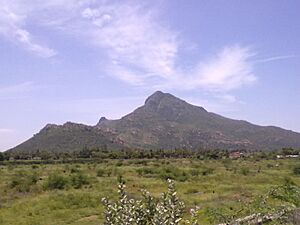
In February 1899, Ramana Maharshi moved to live on Arunachala Hill. He stayed in different caves. He lived in Virupaksha Cave for 17 years.
In 1902, a government official named Sivaprakasam Pillai visited him. He asked Ramana Maharshi questions about "How to know one's true identity." Ramana Maharshi's answers became his first teachings on Self-enquiry. These were later published as Nan Yar? (Who am I?).
Many people came to visit him. Some became his devoted followers. In 1907, a respected scholar named Kavyakantha Sri Ganapati Sastri visited. After learning from Ramana Maharshi, he gave him the name Bhagavan Sri Ramana Maharshi. This is the name he was known by from then on.
In 1911, the first Westerner, Frank Humphreys, visited him. Humphreys wrote articles about Ramana Maharshi. These helped make him known in the West.
In 1916, his mother Alagammal and younger brother Nagasundaram joined him. They lived with him in Skandashram Cave. His mother became a sannyasin too. Ramana Maharshi taught her personally. His younger brother also became a sannyasi.
During this time, Ramana Maharshi wrote The Five Hymns to Arunachala. These were devotional poems. His mother's health got worse in 1920. She died on 19 May 1922. Ramana Maharshi was with her.
Sri Ramanasramam (1922–1950)
After his mother's death, Ramana Maharshi stayed near her tomb. This area became Sri Ramanasramam. At first, there was just one hut. But over time, the ashram grew. It included a library, hospital, and other buildings. Ramana Maharshi was good at planning these building projects.
Ramana Maharshi lived a simple life. He was often active in the ashram. He helped with cooking and other daily tasks. He didn't just sit silently all the time.
Becoming Known in the West (1930–1940)
In 1931, a book about Ramana Maharshi was published. It was called Self Realisation: The Life and Teachings of Ramana Maharshi. His fame grew even more after 1934. This was when Paul Brunton published his book A Search in Secret India. Brunton described his visit to Ramana Maharshi. He also wrote about the strong effect this meeting had on him.
Brunton's book became very popular. It introduced Ramana Maharshi to many people in the West. Famous visitors included Paramahansa Yogananda and William Somerset Maugham.
Final Years (1940–1950)
In November 1948, a small cancerous lump was found on Ramana Maharshi's arm. Doctors tried to remove it. But the growth kept coming back. Doctors suggested amputating his arm, but he refused. More operations were done, but they only made him weaker.
By April 1950, Ramana Maharshi was very weak. He could no longer go to the main hall. Visitors could only pass by his room for a last look. He died on 14 April 1950. At the same time, a shooting star was seen. Many of his followers felt this was a special sign.
Spiritual Teachings
Ramana Maharshi gave spiritual guidance in different ways. He often taught by sitting silently with visitors. He also answered their questions. Many of these talks were written down and published. He also showed an example through his own devotion to Shiva.
The Self
Ramana Maharshi used different words for the "Self." These included "truth-consciousness-bliss" (sat-chit-ananda). He also used terms like God, Brahman, and Siva. He said the "Heart" was the source of everything. He meant the spiritual Heart, not the physical one.
He believed the Self is always there and never dies. Our "true nature" is simply "Being," without any thoughts.
Silence as Teaching
Ramana Maharshi often taught through silence. He would sit quietly with his visitors. He used words only when necessary. He believed this silent presence helped people find their true Self.
Self-Enquiry
Self-enquiry is a key teaching of Ramana Maharshi. It means constantly paying attention to the inner feeling of "I" or "I am." He said it was the most direct way to find Self-awareness.
He explained that the "I-thought" is our sense of being an individual. By asking "Where does this 'I' come from?", the "I-thought" will disappear. Then, the true Self-awareness will appear. This leads to an "effortless awareness of being."
Ramana Maharshi taught that true peace is not just a temporary state. It's a lasting state where you are aware of your true Self, even during daily activities.
Devotion (Bhakti)
Ramana Maharshi also supported the path of bhakti, or devotion. This means surrendering to God or your spiritual teacher. He said this path would eventually lead to the same Self-realization.
Surrender means accepting whatever happens without expectations. It's not about giving up something as an individual. It's about realizing there is no separate individual self to surrender.
Reincarnation
Ramana Maharshi taught that the idea of reincarnation comes from believing the individual self is real. He sometimes spoke about rebirth to help those who couldn't fully understand the idea of no individual self. But when you realize your true self, ideas about death and rebirth no longer apply. There is no birth or death within the Self.
Influence and Legacy
Ramana Maharshi never called himself a guru. He never said he had disciples. He also never named anyone to take his place. He didn't publicly say that anyone else was "liberated" except his mother after she died.
The Sri Ramana Ashram is managed by his younger brother's family. It continues to be a spiritual place. Anyone who wishes can visit and use its facilities.
In the 1930s, Paul Brunton helped spread Ramana Maharshi's teachings in the West. Later, others like Arthur Osborne also helped. Ramana Maharshi's teachings have become very popular in Western spirituality. Many Western spiritual thinkers have been influenced by him.
Writings
Ramana Maharshi didn't write many books on his own. Most of his writings were answers to questions from his followers. Or they were written because his followers asked him to. He wrote a few hymns on his own.
Some of his important writings include:
- Vichāra Sangraham ("Self-Enquiry"): Answers to questions, first published in 1901.
- Nān Yār? ("Who am I?"): Answers to questions, first published in 1923.
- Five Hymns to Arunachala: These are poems praising the holy mountain Arunachala.
- Upadesha Sāra ("The Essence of Instruction"): Thirty verses on spiritual teaching.
- Ulladu narpadu ("Forty Verses on Reality"): Written in 1928.
All these texts are collected in his Collected Works. He also translated some ancient Hindu texts.
Many of his talks were recorded. These were written down by his interpreters. They have been published in collections like Talks with Sri Ramana.
Images for kids
-
Adi Shankara with Disciples, by Raja Ravi Varma (1904)
See also
 In Spanish: Ramana Maharshi para niños
In Spanish: Ramana Maharshi para niños


